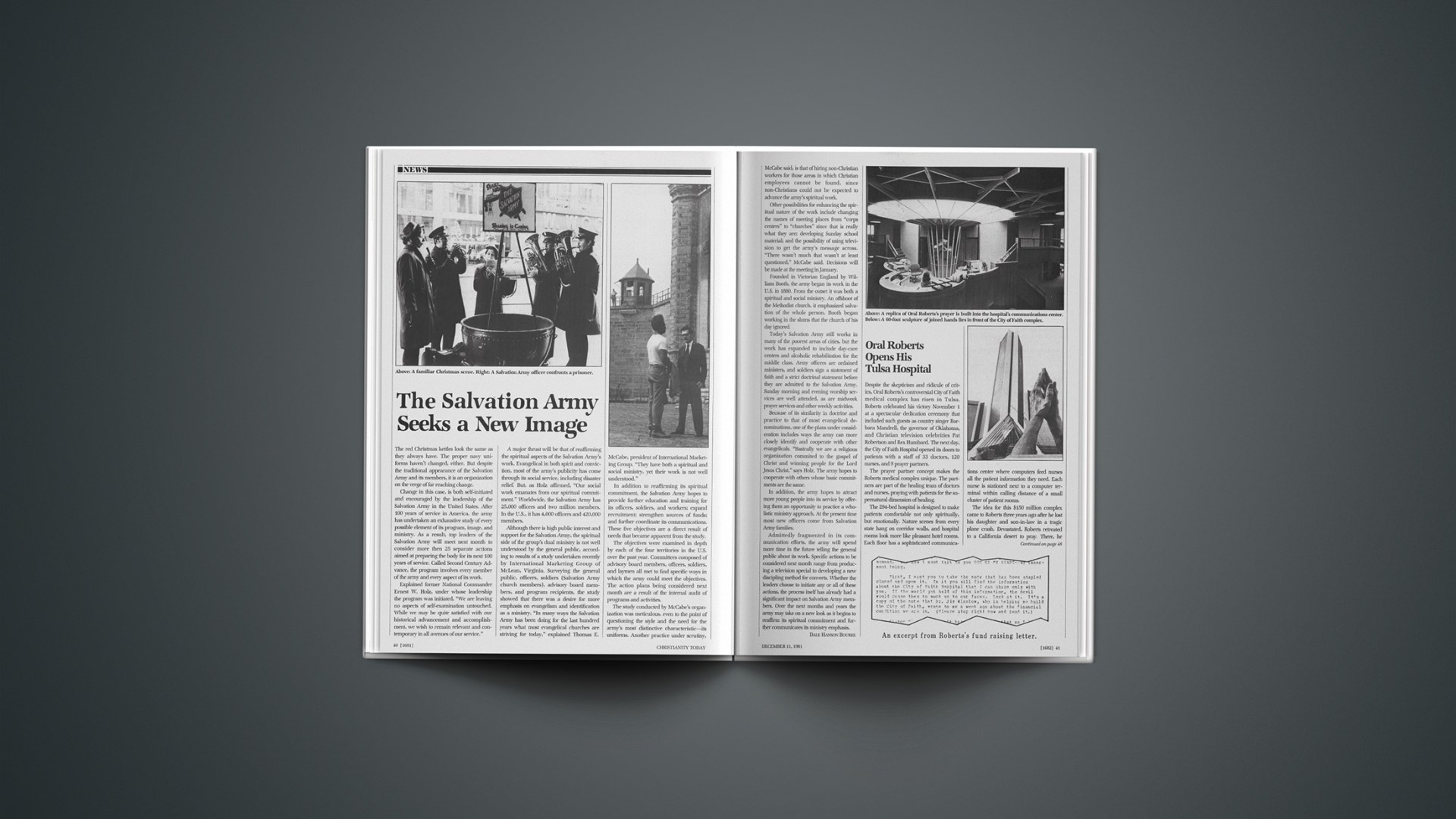The red Christmas kettles look the same as they always have. The proper navy uniforms haven’t changed, either. But despite the traditional appearance of the Salvation Army and its members, it is an organization on the verge of far reaching change.
Change in this case, is both self-initiated and encouraged by the leadership of the Salvation Army in the United States. After 100 years of service in America, the army has undertaken an exhaustive study of every possible element of its program, image, and ministry. As a result, top leaders of the Salvation Army will meet next month to consider more then 25 separate actions aimed at preparing the body for its next 100 years of service. Called Second Century Advance, the program involves every member of the army and every aspect of its work.
Explained former National Commander Ernest W. Holz, under whose leadership the program was initiated, “We are leaving no aspects of self-examination untouched. While we may be quite satisfied with our historical advancement and accomplishment, we wish to remain relevant and contemporary in all avenues of our service.”
A major thrust will be that of reaffirming the spiritual aspects of the Salvation Army’s work. Evangelical in both spirit and conviction, most of the army’s publicity has come through its social service, including disaster relief. But, as Holz affirmed, “Our social work emanates from our spiritual commitment.” Worldwide, the Salvation Army has 25,000 officers and two million members. In the U.S., it has 4,000 officers and 420,000 members.
Although there is high public interest and support for the Salvation Army, the spiritual side of the group’s dual ministry is not well understood by the general public, according to results of a study undertaken recently by International Marketing Group of McLean, Virginia. Surveying the general public, officers, soldiers (Salvation Army church members), advisory board members, and program recipients, the study showed that there was a desire for more emphasis on evangelism and identification as a ministry. “In many ways the Salvation Army has been doing for the last hundred years what most evangelical churches are striving for today,” explained Thomas E. McCabe, president of International Marketing Group. “They have both a spiritual and social ministry, yet their work is not well understood.”
In addition to reaffirming its spiritual commitment, the Salvation Army hopes to provide further education and training for its officers, soldiers, and workers; expand recruitment; strengthen sources of funds; and further coordinate its communications. These five objectives are a direct result of needs that became apparent from the study.
The objectives were examined in depth by each of the four territories in the U.S. over the past year. Committees composed of advisory board members, officers, soldiers, and laymen all met to find specific ways in which the army could meet the objectives. The action plans being considered next month are a result of the internal audit of programs and activities.
The study conducted by McCabe’s organization was meticulous, even to the point of questioning the style and the need for the army’s most distinctive characteristic—its uniforms. Another practice under scrutiny, McCabe said, is that of hiring non-Christian workers for those areas in which Christian employees cannot be found, since non-Christians could not be expected to advance the army’s spiritual work.
Other possibilities for enhancing the spiritual nature of the work include changing the names of meeting places from “corps centers” to “churches” since that is really what they are; developing Sunday school material; and the possibility of using television to get the army’s message across. “There wasn’t much that wasn’t at least questioned,” McCabe said. Decisions will be made at the meeting in January.
Founded in Victorian England by William Booth, the army began its work in the U.S. in 1880. From the outset it was both a spiritual and social ministry. An offshoot of the Methodist church, it emphasized salvation of the whole person. Booth began working in the slums that the church of his day ignored.
Today’s Salvation Army still works in many of the poorest areas of cities, but the work has expanded to include day-care centers and alcoholic rehabilitation for the middle class. Army officers are ordained ministers, and soldiers sign a statement of faith and a strict doctrinal statement before they are admitted to the Salvation Army. Sunday morning and evening worship services are well attended, as are midweek prayer services and other weekly activities.
Because of its similarity in doctrine and practice to that of most evangelical denominations, one of the plans under consideration includes ways the army can more closely identify and cooperate with other evangelicals. “Basically we are a religious organization commited to the gospel of Christ and winning people for the Lord Jesus Christ,” says Holz. The army hopes to cooperate with others whose basic commitments are the same.
In addition, the army hopes to attract more young people into its service by offering them an opportunity to practice a wholistic ministry approach. At the present time most new officers come from Salvation Army families.
Admittedly fragmented in its communication efforts, the army will spend more time in the future telling the general public about its work. Specific actions to be considered next month range from producing a television special to developing a new discipling method for converts. Whether the leaders choose to initiate any or all of these actions, the process itself has already had a significant impact on Salvation Army members. Over the next months and years the army may take on a new look as it begins to reaffirm its spiritual commitment and further communicates its ministry emphasis.










